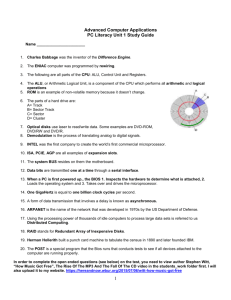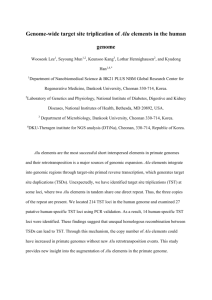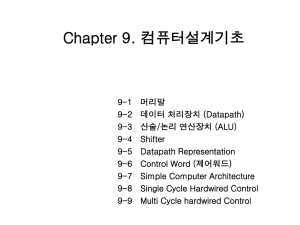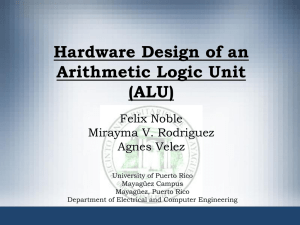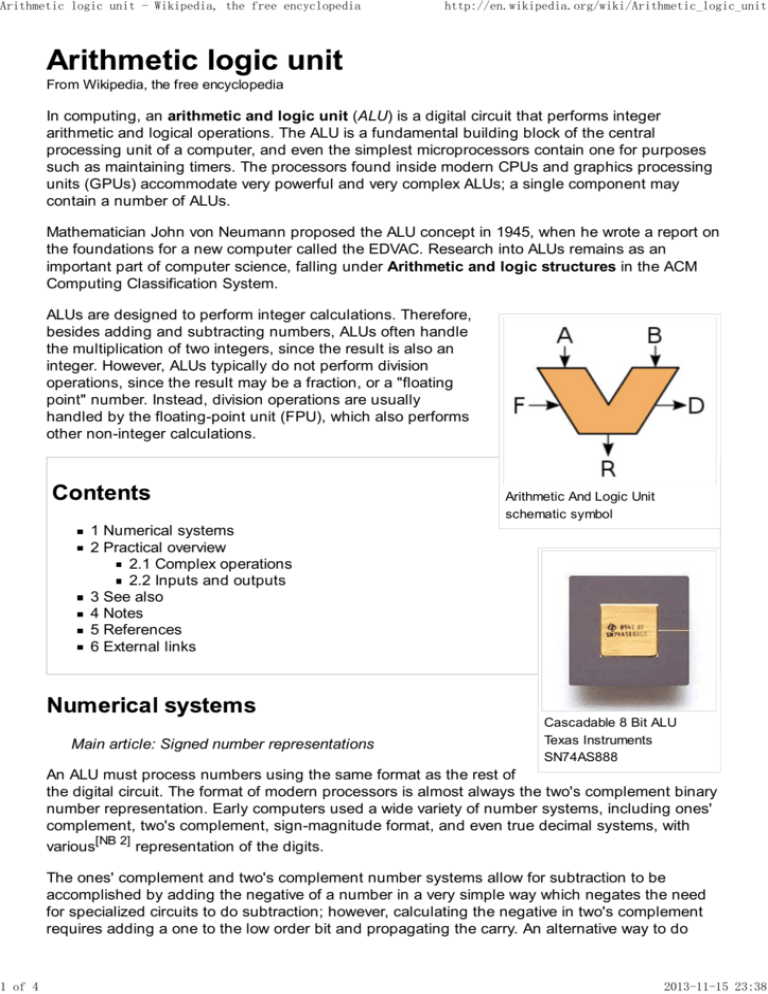
Arithmetic logic unit - Wikipedia, the free encyclopedia
1 of 4
http://en.wikipedia.org/wiki/Arithmetic_logic_unit
From Wikipedia, the free encyclopedia
In computing, an arithmetic and logic unit (ALU) is a digital circuit that performs integer
arithmetic and logical operations. The ALU is a fundamental building block of the central
processing unit of a computer, and even the simplest microprocessors contain one for purposes
such as maintaining timers. The processors found inside modern CPUs and graphics processing
units (GPUs) accommodate very powerful and very complex ALUs; a single component may
contain a number of ALUs.
Mathematician John von Neumann proposed the ALU concept in 1945, when he wrote a report on
the foundations for a new computer called the EDVAC. Research into ALUs remains as an
important part of computer science, falling under Arithmetic and logic structures in the ACM
Computing Classification System.
ALUs are designed to perform integer calculations. Therefore,
besides adding and subtracting numbers, ALUs often handle
the multiplication of two integers, since the result is also an
integer. However, ALUs typically do not perform division
operations, since the result may be a fraction, or a "floating
point" number. Instead, division operations are usually
handled by the floating-point unit (FPU), which also performs
other non-integer calculations.
Arithmetic And Logic Unit
schematic symbol
1 Numerical systems
2 Practical overview
2.1 Complex operations
2.2 Inputs and outputs
3 See also
4 Notes
5 References
6 External links
Main article: Signed number representations
Cascadable 8 Bit ALU
Texas Instruments
SN74AS888
An ALU must process numbers using the same format as the rest of
the digital circuit. The format of modern processors is almost always the two's complement binary
number representation. Early computers used a wide variety of number systems, including ones'
complement, two's complement, sign-magnitude format, and even true decimal systems, with
various[NB 2] representation of the digits.
The ones' complement and two's complement number systems allow for subtraction to be
accomplished by adding the negative of a number in a very simple way which negates the need
for specialized circuits to do subtraction; however, calculating the negative in two's complement
requires adding a one to the low order bit and propagating the carry. An alternative way to do
2013-11-15 23:38
Arithmetic logic unit - Wikipedia, the free encyclopedia
2 of 4
http://en.wikipedia.org/wiki/Arithmetic_logic_unit
two's complement subtraction of A−B is to present a one to the carry input of the adder and use
¬B rather than B as the second input. The arithmetic, logic and shift circuits introduced in
previous sections can be combined into one ALU with common selection.
Most of a processor's operations are performed by one or more ALUs. An ALU loads data from
input registers. Then an external control unit tells the ALU what operation to perform on that data,
and then the ALU stores its result into an output register. The control unit is responsible for
moving the processed data between these registers, ALU and memory.
Complex operations
Engineers can design an Arithmetic Logic Unit to calculate most operations. The more complex
the operation, the more expensive the ALU is, the more space it uses in the processor, and the
more power it dissipates. Therefore, engineers compromise. They make the ALU powerful enough
to make the processor fast, yet not so complex as to become prohibitive. For example, computing
the square root of a number might use:
1. Calculation in a single clock Design an extraordinarily complex ALU that calculates the
square root of any number in a single step.
2. Calculation pipeline Design a very complex ALU that calculates the square root of any
number in several steps. The intermediate results go through a series of circuits arranged
like a factory production line. The ALU can accept new numbers to calculate even before
having finished the previous ones. The ALU can now produce numbers as fast as a
single-clock ALU, although the results start to flow out of the ALU only after an initial delay.
3. Iterative calculation Design a complex ALU that calculates the square root through several
steps. This usually relies on control from a complex control unit with built-in microcode.
4. Co-processor Design a simple ALU in the processor, and sell a separate specialized and
costly processor that the customer can install just beside this one, and implements one of
the options above.
5. Software libraries Tell the programmers that there is no co-processor and there is no
emulation, so they will have to write their own algorithms to calculate square roots by
software.
6. Software emulation Emulate the existence of the co-processor, that is, whenever a
program attempts to perform the square root calculation, make the processor check if there
is a co-processor present and use it if there is one; if there is not one, interrupt the
processing of the program and invoke the operating system to perform the square root
calculation through some software algorithm.
The options above go from the fastest and most expensive one to the slowest and least expensive
one. Therefore, while even the simplest computer can calculate the most complicated formula,
the simplest computers will usually take a long time doing that because of the several steps for
calculating the formula.
Powerful processors like the Intel Core and AMD64 implement option #1 for several simple
operations, #2 for the most common complex operations and #3 for the extremely complex
operations.
Inputs and outputs
The inputs to the ALU are the data to be operated on (called operands) and a code from the
control unit indicating which operation to perform. Its output is the result of the computation. One
2013-11-15 23:38
Arithmetic logic unit - Wikipedia, the free encyclopedia
3 of 4
http://en.wikipedia.org/wiki/Arithmetic_logic_unit
thing designers must keep in mind is whether the ALU will operate on big-endian or little-endian
numbers.
In many designs, the ALU also takes or generates inputs or outputs a set of condition codes from
or to a status register. These codes are used to indicate cases such as carry-in or carry-out,
overflow, divide-by-zero, etc.
A floating-point unit also performs arithmetic operations between two values, but they do so for
numbers in floating-point representation, which is much more complicated than the two's
complement representation used in a typical ALU. In order to do these calculations, a FPU has
several complex circuits built-in, including some internal ALUs.
In modern practice, engineers typically refer to the ALU as the circuit that performs integer
arithmetic operations (like two's complement and BCD). Circuits that calculate more complex
formats like floating point, complex numbers, etc. usually receive a more specific name such as
FPU.
7400 series
74181
Adder (electronics)
Multiplication ALU
Digital circuit
Division algorithm
Control unit
Central Processing Unit
Bus (computing)
1. ^ a b IBM and UNIVAC used the term biquinary with different meanings.
2. ^ Including Binary-Coded Decimal (BCD) in 4 bits, 2-out-of-5 coding in five bits,[1] 5-bit biquinary[NB 1]
encoding,[2] and 2-out-of-seven biquinary[NB 1] encoding in 7 bits[3]
1. ^ Reference Manual, 7070 Data Processing System, A22-7003-01 (http://bitsavers.org/pdf/ibm
/7070/A22-7003-01_7070_Reference_Jan60.pdf)
2. ^ UNIVAC SOLID-STATE 90 Specification Features (http://bitsavers.org/pdf/univac
/uss/SolidState90_Specs.pdf)
3. ^ 650 Data Processing Machine Manual of Operation, 22-6060-2 (http://bitsavers.org/pdf/ibm
/650/22-6060-2_650_OperMan.pdf)
Hwang, Enoch (2006). Digital Logic and Microprocessor Design with VHDL
(http://faculty.lasierra.edu/~ehwang/digitaldesign) . Thomson. ISBN 0-534-46593-5.
Stallings, William (2006). Computer Organization & Architecture: Designing for Performance
(http://williamstallings.com/COA/COA7e.html)
(7th ed.). Pearson Prentice Hall.
ISBN 0-13-185644-8.
2013-11-15 23:38
Arithmetic logic unit - Wikipedia, the free encyclopedia
4 of 4
http://en.wikipedia.org/wiki/Arithmetic_logic_unit
ALU and its Micro-operations: Bitwise, Arithmetic and Shift (http://www.fullchipdesign.com
/tyh/alu_arithmetic_logical_unit.htm)
A Simulator of Complex ALU in MATLAB (http://www.mathworks.com/matlabcentral
/fileexchange/loadFile.do?objectId=12762&objectType=FILE)
Retrieved from "http://en.wikipedia.org/w/index.php?title=Arithmetic_logic_unit&oldid=576642074"
Categories: Digital circuits Central processing unit Computer arithmetic
This page was last modified on 29 October 2013 at 08:30.
Text is available under the Creative Commons Attribution-ShareAlike License; additional
terms may apply. By using this site, you agree to the Terms of Use and Privacy Policy.
Wikipedia® is a registered trademark of the Wikimedia Foundation, Inc., a non-profit
organization.
2013-11-15 23:38




